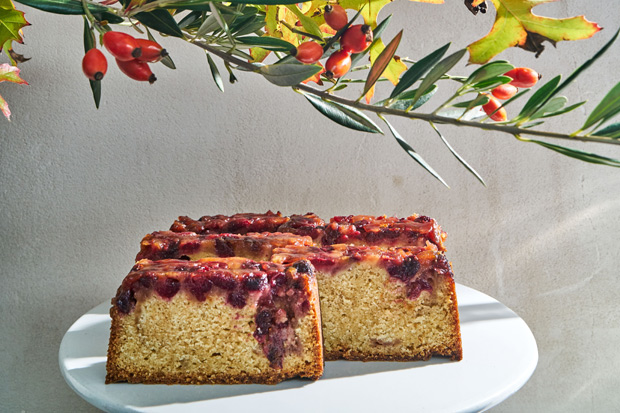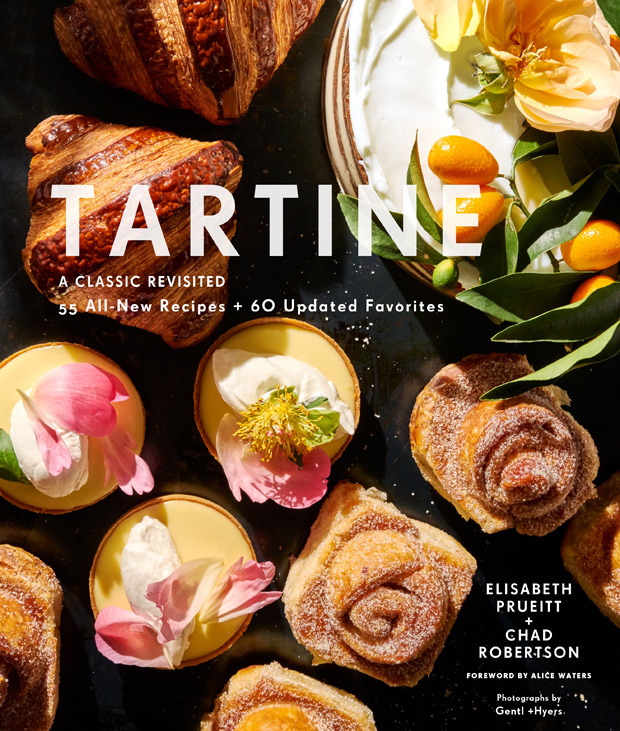Recipe
September 26, 2019
Cranberry Upside-Down Cake

Try this Cranberry Upside-Down Cake recipe from the cookbook Tartine: A Classic Revised.
 Our baker Carolyn has transformed what is usually a sweet summertime cake made with peaches or pineapple into a beautiful winter version using caramel-coated cranberries, which turn out of their baking mold perfectly juicy and glazed, ready to serve. The cake is tender and moist, and ideal with tart fruit.
Our baker Carolyn has transformed what is usually a sweet summertime cake made with peaches or pineapple into a beautiful winter version using caramel-coated cranberries, which turn out of their baking mold perfectly juicy and glazed, ready to serve. The cake is tender and moist, and ideal with tart fruit.
Directions
Yield: Serves 8 to 10
- Preheat the oven to 325°F (160°C). Butter a 10 by 5 inch (25 by 12 cm) loaf pan and line with parchment paper, leaving a few inches of overhang on each side.
- To prepare the fruit layer, combine the cranberries, brown sugar and orange zest in a bowl and gently mix with your hands or a rubber spatula to coat the cranberries and evenly distribute the sugar and zest. With a spoon, transfer the fruit from the bowl to the prepared pan, keeping in mind that there will be more fruit than the bottom of the pan can accommodate. The cranberries will shrink during baking so the fruit settles into an even layer.
- To prepare the caramel, stir together the brown sugar and butter in a small, heavy saucepan; bring the mixture just to a boil over medium-low heat, stirring to combine with a rubber spatula, so the sugar doesn’t burn before the butter is fully melted. When the caramel has softened and begun to boil, remove the pan from the heat. Immediately pour the caramel evenly over the fruit mixture in the loaf pan and set aside to cool and set without agitating the mixture.
- To make the cake, sift the flour, baking powder and baking soda into the bowl of a stand mixer fitted with the paddle attachment. Add the granulated sugar and salt and stir to combine. In a small bowl, whisk together the eggs, crème fraîche and vanilla extract. Add the softened butter to the dry ingredients in the mixer bowl. Mix on low speed until the mixture is sandy and the butter can no longer be seen. Add the egg mixture, and then beat thoroughly on medium speed until the batter is smooth, about 1 minute, stopping the mixer halfway through to scrape down the sides of the bowl with a rubber spatula.
- Pour the cake batter on top of the fruit and caramel in the prepared pan and smooth to the edges with an offset spatula. Give the pan a few hard raps on the counter to knock out any air bubbles from the batter.
- Bake the cake until it has risen and become a deep golden brown color, and a cake tester inserted into the center comes out clean, about 1 hour. It might require more time. Let cool in the pan on a wire rack for 30 minutes. To unmold, run a small, thin knife around the sides to detach any hardened bits of caramel from the cake pan. Place an inverted serving dish onto the surface of the cake, and, using a towel or oven mitts, flip the cake pan and dish and carefully slide the pan from the cake. Gently peel off the parchment and allow the cake to continue cooling at room temperature for 1 hour before serving. The cake will keep, covered at room temperature, for up to 3 days.
Source:
Excerpted from Tartine: Revised Edition (C) 2019 by Elisabeth M. Prueitt and Chad Robertson. Photographs by Gentl + Hyers. Reproduced by permission of Chronicle Books. All rights reserved.

